Long-term resident at McClellan in California, F-86F s/n 51-13082
is now being restored to static display standard by a team from the
Aerospace Museum of California. Crew Chief on the Sabre is Dick Gold,
who has a long association with the type:
"As a young child, I would
beg my older sister to drive me the 7 miles from our home to the end
of Runway 16 Right at Van Nuys Airport. There I would spend hours
watching the aircraft taking off and going directly over my head.
I was especially interested in the Sabres flown by the 146th Fighter
Wing that was located at the airport. Both the 115th and 195th Fighter
Squadrons were based there. As I watched and listened to their mighty
roar, I imagined myself at the controls of one of those awesome jets.
It was there that I made up my mind that someday I was going to fly
one. Well some 11 years later I got out of the regular Air Force as
an aircraft mechanic and joined the 115th . The Sabres were long gone
but I still wanted to fly so within a month I was off to Flight Engineer
School and four months later was flying the C-97 transports that were
now stationed at Van Nuys. Several of the Sabre pilots remained with
both the 115th and 195th flying the C-97’s so I got to fly with them
and hear some of their stories about how great it was to fly the Sabre."
"Although many of those pilots
and most of the maintainers have taken their final flights, some are
still going. One of those is Col. Larry Powell who was the Commander
of the 195th FS and as soon as we are ready, I hope he will be the
one to unveil our newly painted and restored 195th F-86F 51-13082."
As detailed below, the Museum's
F-86F spent a good many years displayed outside at Gaviota and Goleta
and those years took their toll. By the time the Sabre arrived at
McClellan, all traces of its former identity had gone as Dick Gold
relates,
"It arrived with a very basic
white or silver paint job with US Air force on the fuselage, stars
and bars and the tail number. After arriving at McClellan it was repainted
to resemble the famous “Boomerang” that John Conroy flew coast to
coast. The paint job was close but not exact! Also sometime after
arriving at McClellan, the seat, rails and armor plate were removed
by someone who remains unknown. There may have been other cockpit
stuff removed at that time. As you can see in the pictures, there’s
not much left. Fortunately the aircraft exterior remained in pretty
good shape."
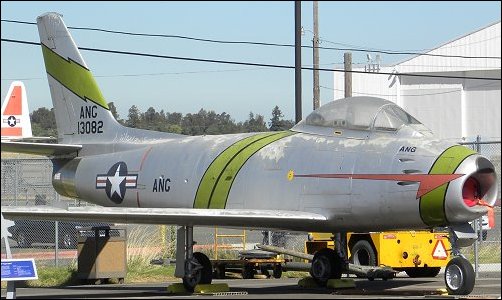
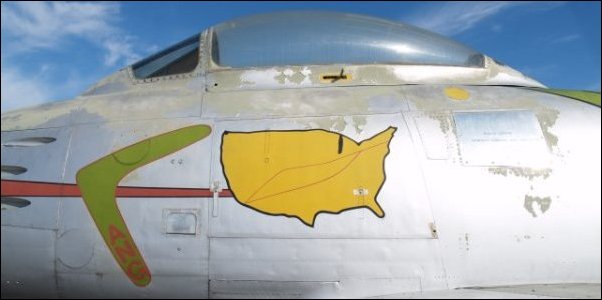
‘082 in her 'California Boomerang' 115th FIS CA ANG colours,
prior to restoration starting.
"Since taking over the Crew
Chief job some 3 years ago, I have replaced the nose gear tire and
wheel, added a missing lower nose gear door and linkage, and the nose
gear steering damper. I have been collecting cockpit parts for almost
three years and will begin to start that part of the restoration once
the exterior is done. Prior to paint, we have some minor sheet metal
repairs and need to replace some missing screws and fasteners."
"Our goal is
to have her painted and ready to show by the first week of January
[2011] (weather permitting) and start the cockpit once she’s inside
the museum “showroom”. As there’s really only room for one inside
the cockpit, we will pre-assemble most of it then start installation."
As Dick
mentioned, the restoration team are going to paint ‘082 in an overall
silver colour scheme representative of 195th FIS F-86As. The silver-painted
(rather than natural metal finish) scheme is not inaccurate either:
the CA ANG squadrons were unusual in having silver-painted F-86s in-period.
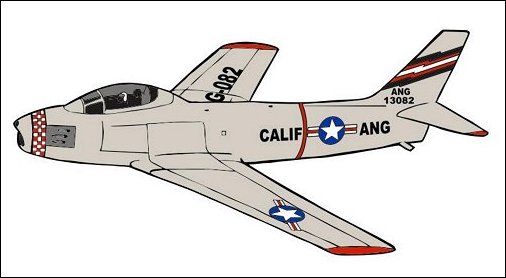
This is how ‘082 should look after restoration.
December
2010 Report

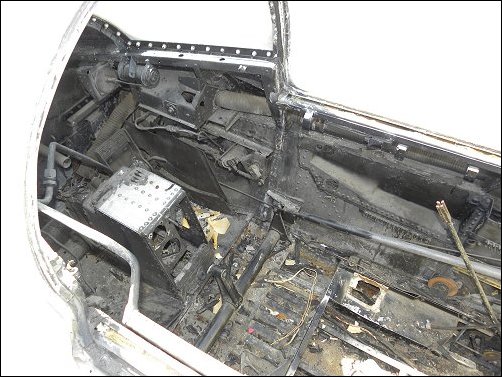
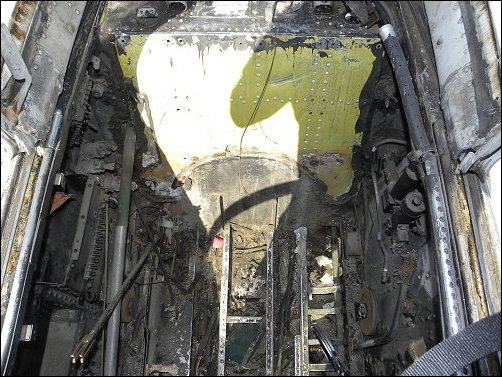
These recent cockpit shots show how comprehensively the interior
has been stripped out over the years. With luck this situation will
soon change.
The major task
of sanding the aircraft has now been completed and because the aircraft
will be displayed outdoors and sprayed silver overall, this process
will not go back to bare metal. Even in this state it is easy to appreciate
how good the general condition of the aircraft skin is.

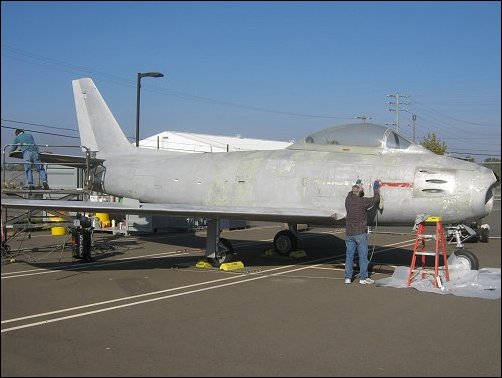
Above left: The sanding
process begins and (right) many hours of elbow grease later the
surface is almost flatted down. Below: The sanding completed. Metalwork
repairs are next on the agenda.
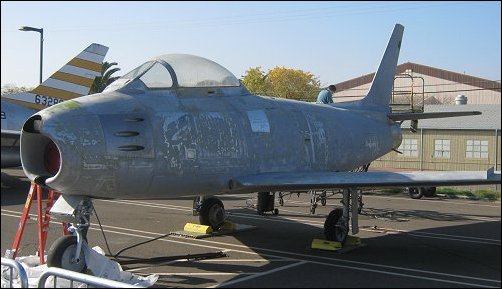
Service
History of 51-13082:
Aircraft s/n
51-13082 with construction number 176-13 was built as an F-86F-20
at the North American Aviation (NAA) Columbus, Ohio factory in 1952
and was declared available on July 21st. The aircraft was then accepted
on August 27th 1952 and delivered to the US Air Force on September
5th that year under Air Defense Command (ADC) Project 2F-678. As such
the aircraft was quite unusual since most F-86s were built on the
West Coast at the Inglewood, California plant. However with the bankruptcy
of the Curtiss- Wright aircraft company the large government-owned
factory in Columbus became available and NAA moved in. The F-86F was
the first NAA product to be built at Columbus and was followed by
numerous F- 86H and FJ Fury fighters.
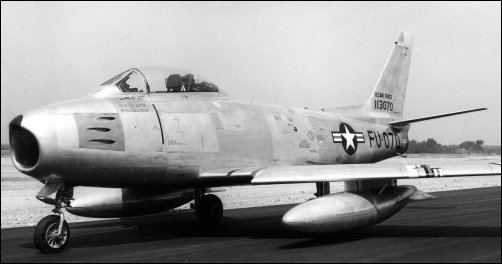
Fresh from
rollout at Columbus, F-86F-20 s/n 51-13070. The McClellan Sabre
was just twelve places behind it on the production line.
First unit assignment
for ‘082 was with 126th Fighter Interceptor Squadron, Wisconsin ANG
at Truax AFB on 3 September 1952. The 126th had been ordered to active
service on March 1st 1951 and redesignated from 126th Fighter Squadron
(Jet) the following month. The squadron was initially part of 128th
Fighter Interceptor Group, flying F-80A Shooting Stars, but with active
duty assignment its parent organization became 31st Air Division in
February 1952 as part of the USAF ADC commitment. F-86Fs began arriving
at Truax in April 1952 and the squadron then moved to Mitchell ANG
Base on November 1st 1952.
With release
of 126th FIS from active duty on December 1st 1952, 51-13082 was simultaneously
reassigned to 432nd FIS, which gained the role and assets of the Guard
unit. All the Sabres departed the WI ANG at this time and like many
ANG squadrons returned to State control, the 126th took a step backwards
and began flying the F-51D Mustang.
Meanwhile ‘082
had been reassigned to 432nd FIS at Truax AFB on December 1st 1952.
However, with the squadron starting to convert to F-86D interceptors
in June 1953, the aircraft’s time with the squadron was short: on
July 7th that year, ‘082 was transferred out to 18th FIS at Minneapolis-St
Paul International Airport.
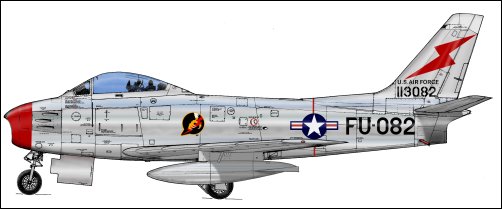
51-13082
in 432nd FIS colours.
But again this
was only a short stint: within six months 18th FIS began to prepare
for delivery of F-89 Scorpions and relocated to Alaska. Instead of
moving north, 51-13082 instead was sent to the Warner Robins Air Materiel
Area at Robins AFB, Georgia on January 4th 1954 for overhaul. On May
25th 1954 the aircraft left Robins AFB on assignment to 49th FIS at
Dow AFB in Maine. It was to be another short stay.
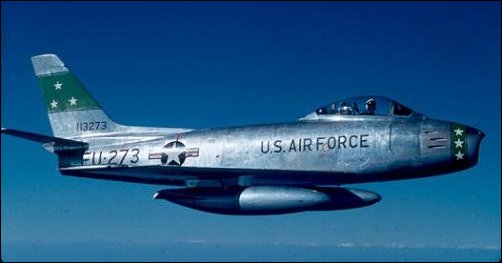
Though this
photo does not depict ‘082, it does show the typical 49th FIS colour
scheme she would have worn in the summer of 1954.
‘082 passed to
3595th Combat Crew Training Wing at Nellis AFB, near Las Vegas NV
on 13th December 1954. It was an interesting time for the huge training
unit at Nellis, for at this point the last F-86As had only just departed
and a mix of F-86E and F-86F aircraft were on strength. F-86Hs also
began to arrive at Nellis in early 1955. Accidents were rife and ‘082
was lucky to survive unscathed: in a 2-year period from July 1952
the unit lost nineteen F-86Es in flying accidents.
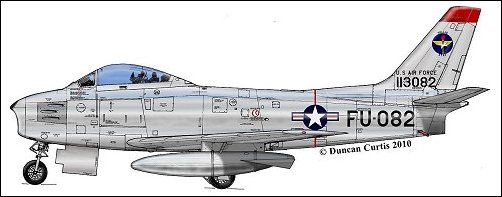
51-13082
in 3595th CCTW colours.
On 12th January
1956, 51-13082 passed to 3525th CCTW at Williams AFB AZ and continued
its crew training role. 3525th had taken on all F-86 day fighter training
by this time, as Nellis concentrated on more modern fighters such
as the F-100 Super Sabre. Aside from the regular USAF, ANG and AFRES
crews who passed through the Williams AFB, the 3525th also began training
overseas pilots on the Sabre during this period. Many of these prospective
pilots would fly Sabres in their home countries upon completion of
training and included students from Japan, Colombia, Pakistan and
Spain.
For 51-13082,
after just over a year at Williams AFB a further period of overhaul
followed, this time with Pacific Airmotive at Chino CA from November
7th 1956. It seems likely that the aircraft was fitted with the extended-chord,
non-slatted ‘6-3’ wing leading edge at this time: F-86Es at the training
units had generally retained the slatted wing (which had better stall
characteristics – a bonus in the training environment). However it
is certain that ‘082 had this modification at some point in its later
career and it is also certain that she left the factory with the slatted
wing because the first Columbus-built F-86F to feature the ‘6-3’ modification
was s/n 51-13341.
Fresh from this
overhaul the aircraft then departed on assignment to 121st FIS DC
Air National Guard (ANG) at Andrews AFB, MD on May 8th 1957. This
was yet another short period of duty, with the squadron beginning
to convert to the F-86H.
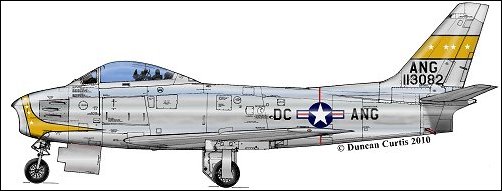
It is not
known whether 51-13082 wore the full 121st FIS colours, but this
rendition shows the squadron’s F-86E/F colour scheme (the squadron’s
Sabres were divided into flights and the aircraft wore yellow, red
or blue variations of this scheme). ‘082 probably was also fitted
with the ‘6-3’ wing by this time.
And so on October
20th 1957 the aircraft was reassigned, this time to 115th FIS CA ANG
at Van Nuys. The squadron was re-equipping from the earlier F-86A
model at this time. Thankfully the next few years would be reasonably
stable. The 115th was redesignated as a Tactical Fighter Squadron
(TFS) on November 10th 1958 but remained under 146th Fighter Group
control.
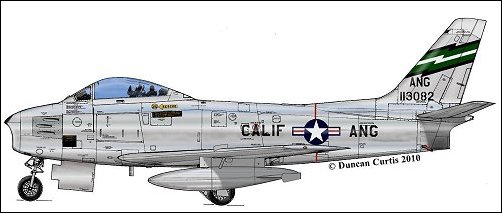
51-13082
in 115th TFS CA ANG colours.
Markings carried
at this time should have complied with Technical Order 1-1-636 dated
29 November 1957, which stated that the letters ‘ANG’ must appear
on the vertical tail above the radio call numbers and ‘ANG- 082’ would
be painted on upper right and lower left wing surfaces. The State
abbreviation and ‘ANG’ would also be applied on each side of fuselage
and the data block stencil below the LH windshield would replace ‘US
Air Force’ with ‘Air National Guard’.
Early in 1959
new markings were applied to Air National Guard aircraft. These markings
copied changes the USAF had made during 1955 and were detailed in
TO 1-1-636 dated 15 July 1959. The ‘ANG’ was removed from the tail
and the ‘ANG-082’ was removed from the upper right and lower left
wings. These areas were now left blank. On the fuselage, the state
abbreviation followed by ‘Air Guard’ was applied. State names with
six or less letters would be spelled out in full and letters could
be reduced in size to fit the name in the same space. Data Block requirements
were unchanged. It seems likely that some or all of these later marking
changes were not applied to ‘082 because they took a while to fully
come into force. By the time they did, the aircraft had passed from
the active inventory.
The final service
assignment of ‘082’s career occurred on March 31st 1959 but it was
only a short move: this time to 195th TFS CA ANG, still at Van Nuys
and still coming under 146th Fighter Group. But with the squadron
briefly changing over to F-86H models (within six months the 195th
changed its role to transport and converted to the C-97G Stratofreighter),
the F-86E models were ferried out.
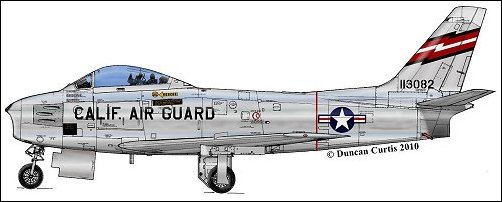
Final military
scheme worn by ‘082: 195th TFS CA ANG colours applied in accordance
with TO 1-1- 636.
Thus, on October
8th 1959, F-86E s/n 51-13082 was donated, probably direct to to Vista
del Mar School at Gaviota CA (though more accurately the school is
in Las Cruces). During its tenure at Gaviota the aircraft’s canopy
was broken. Some time later it was transferred to a VFW Post at nearby
Goleta.
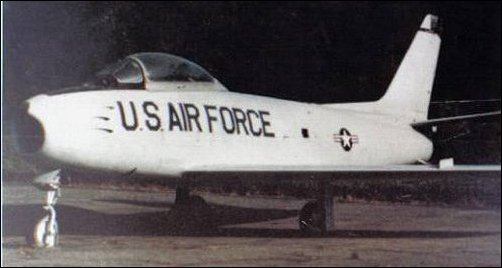
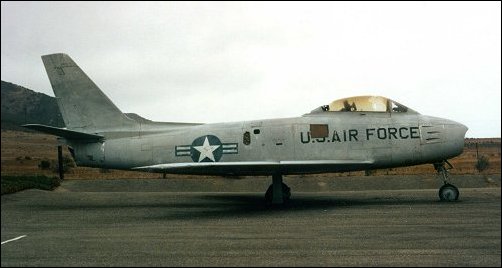
The two photos
above show ‘082 during its time at Vista Del Mar. Note that the
ejection seat was still present at this time. (courtesy of Tom Noack
and Roger Gresham) .
Finally the aircraft
was transferred to the McClellan AFB collection, where it remains
today. On arrival at the museum, the aircraft had been repainted to
represent John Conroy’s ‘California Boomerang’ coast-to-coast aircraft
from 195th FIS. However lately that scheme had started to look tired
and along with the stripped-out cockpit, needed the attention of the
restoration team from the museum.
If
you can help the Museum with spare parts or assistance, email Dick
Gold at: da11@surewest.net

